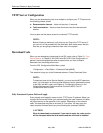
Glossary
GL-3
8000-A2-GB26-00
May 1998
Network Management System. A computer system used for monitoring and controlling
network devices.
Network Service Provider. A local telephone company or ISP that provides network
services to subscribers.
A group of control and data characters that are switched as a unit within a communications
network.
An IP-based application used to test reachability of destinations by sending an ICMP echo
request and waiting for a reply. The ping program is supported from both the DSL and
MCC cards.
Plain Old Telephone Service. Standard telephone service over the PSTN with an analog
bandwidth of less than 4 Hz.
A device that filters out the DSL signal and allows the POTS frequencies to pass through.
Point-to-Point Protocol. as specified by Internet RFC 1661.
Proxy Address Resolution Protocol (ARP). A technique for using a single IP address for
multiple networks. A device responds to ARP requests with its own physical address, then
routes packets to the proper recipients.
A device that connects LANs by dynamically routing data according to destination and
available routes.
A table used by a node to route traffic to another node in the multiplexer network.
Remote Termination Unit. A DSL device installed at the customer premises.
Interface name of a DSL card’s DSL port #1.
Interface name of a DSL card’s DSL port #2.
Interface name of a DSL card’s DSL port #3.
Interface name of a DSL card’s DSL port #4.
Endpoint modem at the customer premise, also known as a Remote Termination Unit
(RTU). There are two model types. See RADSL and MVL.
Simple Network Management Protocol. Protocol for open networking management.
An application level program that facilitates communication between an SNMP
management system and a device.
See
NMS.
A message sent to an SNMP manager to notify it of an event, such as a device being
reset.
A user-specified permanent entry into the routing table that takes precedence over routes
chosen by dynamic routing protocols.
The subnet portion of an IP address. In a subnetted network, the host portion of an IP
address is split into a subnet portion and a host portion using an address (subnet) mask.
This allows a site to use a single IP network address for multiple physical networks.
A number that identifies the subnet portion of a network address. The subnet mask is a
32-bit Internet address written in dotted-decimal notation with all the 1s in the network and
subnet portions of the address.
Transmission Control Protocol. An Internet standard transport layer protocol defined in
STD 7, RFC 793. It is connection-oriented and stream-oriented.
NMS
NSP
packet
PING
POTS
POTS Splitter
PPP
proxy ARP
Router
Routing Table
RTU
s1c
s1d
s1e
s1f
Service Node
SNMP
SNMP agent
SNMP trap
static route
subnet address
subnet mask
TCP


















